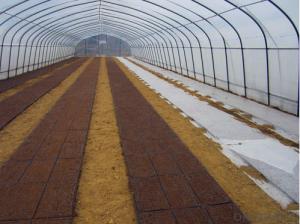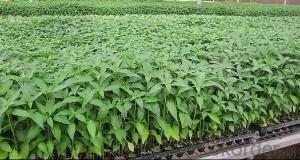Plastic Flower Propagator Seed Tray and Lid
- Loading Port:
- China main port
- Payment Terms:
- TT OR LC
- Min Order Qty:
- 2000 pc
- Supply Capability:
- 2000000 pc/month
OKorder Service Pledge
OKorder Financial Service
You Might Also Like
Brief Introduction to CNBM:
CNBM International Corporation (CNBM International) is the most important trading platform of CNBM Group Corporation, a state-owned company under the direct supervision of State-owned Assets Supervision and Administration Commission of the State Council.
CNBM International is highly recognized by its business partners and clients all over the world and has obtained rapid development under the spirit of win-win. We will carry on the mutual beneficial, innovative and revolutionary trading structure as we did before, create value for our employees, share holders and clients and benefit the whole society in our future development.
Features:
Material: HIPS
Thickness: 0.5mm-1.5mm, Standard:1mm
Weight: 80g(±5)g-230g(±5)g, Standard weight:155g(±5)g
Size: length:490mm-540mm, width:190mm-345mm,depth:25mm-150mm
Standard:540mmX280mm
Cell count: 18-512
Package: In Carton
Warrenty: 8-10 times
Picture:



Specification:
FAQ:
Q:1.How many times can the seed tray be used?
A: Under the same environment, it is decided by the thickness. Usually 0.6mm thickness can be used for 1 or 2 times.
1.0 thickness can be used for 3-4 times. 1.5 thickness can be used for 8-10 times.
Q: 2.How long is the production time?
A: Usually one to two weeks.
Q: 3.How is the seed tray being packaged?
A: They can be packaged in carton or pallets. Carton size is 55cm*29cm*50cm.
- Q: What are the different thickness options available for agricultural plastic products?
- The different thickness options available for agricultural plastic products can vary depending on the specific product and its intended use. However, common thickness options range from 1 mil to 6 mils, with thicker options available for more heavy-duty applications.
- Q: Can agricultural plastic products be used in aquaculture?
- Yes, agricultural plastic products can be used in aquaculture. Plastic materials like polyethylene and polypropylene are commonly used in aquaculture for various purposes such as constructing fish tanks, ponds, and netting systems. These plastic products provide durability, flexibility, and resistance to corrosion, making them suitable for aquaculture applications. Additionally, plastic mulch films are also used in aquaponics systems to enhance plant growth and manage water usage efficiently.
- Q: This question asks about the methods farmers use to ensure that the plastic products used in agriculture comply with safety standards.
- <p>Farmers ensure their agricultural plastic products meet safety standards by sourcing from certified manufacturers, adhering to industry regulations, and regularly testing the products. They use materials that are approved for agricultural use, avoiding harmful chemicals and additives. They also follow proper installation and disposal protocols to minimize environmental impact. Regular inspections and maintenance help identify any potential issues early. Additionally, farmers stay updated on new safety guidelines and participate in training programs to enhance their knowledge and practices.</p>
- Q: How does ground cover impact the overall soil nutrient cycling?
- Ground cover plays a significant role in soil nutrient cycling as it helps to improve soil fertility and nutrient availability. By covering the soil surface, ground cover plants protect the soil from erosion and excessive evaporation, which helps to retain essential nutrients in the soil. Additionally, ground cover plants, such as legumes, have the ability to fix nitrogen from the atmosphere and convert it into a usable form for other plants, increasing soil nitrogen levels. Furthermore, ground cover plants also contribute to organic matter accumulation through the deposition of leaves and other plant debris, which enhances nutrient cycling and soil structure. Overall, ground cover plays a crucial role in maintaining and enhancing soil nutrient levels, benefiting the overall health and productivity of the ecosystem.
- Q: Are nursery trays suitable for starting butterfly host plants?
- Yes, nursery trays are suitable for starting butterfly host plants. They provide a controlled and protected environment for the plants to grow and establish their root systems before being transplanted into a larger garden. Nursery trays also allow for easy monitoring and care of the plants, ensuring they receive the necessary nutrients and water for healthy growth.
- Q: Are nursery trays suitable for hydroponic gardening?
- Yes, nursery trays are suitable for hydroponic gardening. They provide a convenient and efficient way to start and grow plants hydroponically. Nursery trays are designed to hold and support plants while allowing for proper aeration, drainage, and water circulation. They also help in organizing and optimizing space for the hydroponic system.
- Q: I am planning on making a small greenhouse with a wooden frame this summer. Could i use plastic wrap or freight wrap as the walls and roof?(what would be used to wrap goods being transported) I don't have a lot of money to build it with. So would this work decently well and serve purpose well enough for a small greenhouse to grow in? thanks for any help!
- Heavier plastic sheeting would be more durable. But its still inexpensive and readily available at Home Depot or Lowes. Get the heaviest you can afford and then staple gun it to your wood supports.
- Q: Can nursery trays be used for starting vegetable gardens?
- Yes, nursery trays can be used for starting vegetable gardens. They provide a convenient and organized way to start seeds or propagate seedlings before transplanting them into a larger garden bed or container. Nursery trays also help protect young plants from harsh weather conditions and pests, ensuring better chances of successful growth.
- Q: the cistern on my loo is plastic.it's a little discoloured and i'd like to paint it uld i use white emulsion or gloss,which i have,or do i need to get a different type of paint?
- When using emulsion paint to paint plastic you have to thoroughly clean the surface so it is free of dirt, stains and oil residue for the paint to adhere properly. I would recommend using Krylon Fusion for Plastic, you can paint plastic without preparing the surface before painting...bonds directly with plastic and dries in 15 minutes.
Send your message to us
Plastic Flower Propagator Seed Tray and Lid
- Loading Port:
- China main port
- Payment Terms:
- TT OR LC
- Min Order Qty:
- 2000 pc
- Supply Capability:
- 2000000 pc/month
OKorder Service Pledge
OKorder Financial Service
Similar products
Hot products
Hot Searches
Related keywords































